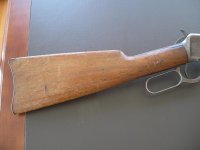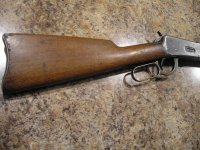Hello.....
I have a Winchester 1894 .32 Special lever action rifle that has been passed down to me .....All the information I could find out is by a serial number trace,and it was made in 1923.....The bluing on the tube and barrel is in fine shape.....The receiver is an odd silver color,it almost looks like it is plated,and never blued.....I would have thought it was blued and worn but it is very uniform in color.....It has some sort of flip-up adjustable sight behind the hammer on the stock just about where it meets the receiver with a peep-sight on top of it.....Thanks folks..
I have a Winchester 1894 .32 Special lever action rifle that has been passed down to me .....All the information I could find out is by a serial number trace,and it was made in 1923.....The bluing on the tube and barrel is in fine shape.....The receiver is an odd silver color,it almost looks like it is plated,and never blued.....I would have thought it was blued and worn but it is very uniform in color.....It has some sort of flip-up adjustable sight behind the hammer on the stock just about where it meets the receiver with a peep-sight on top of it.....Thanks folks..


